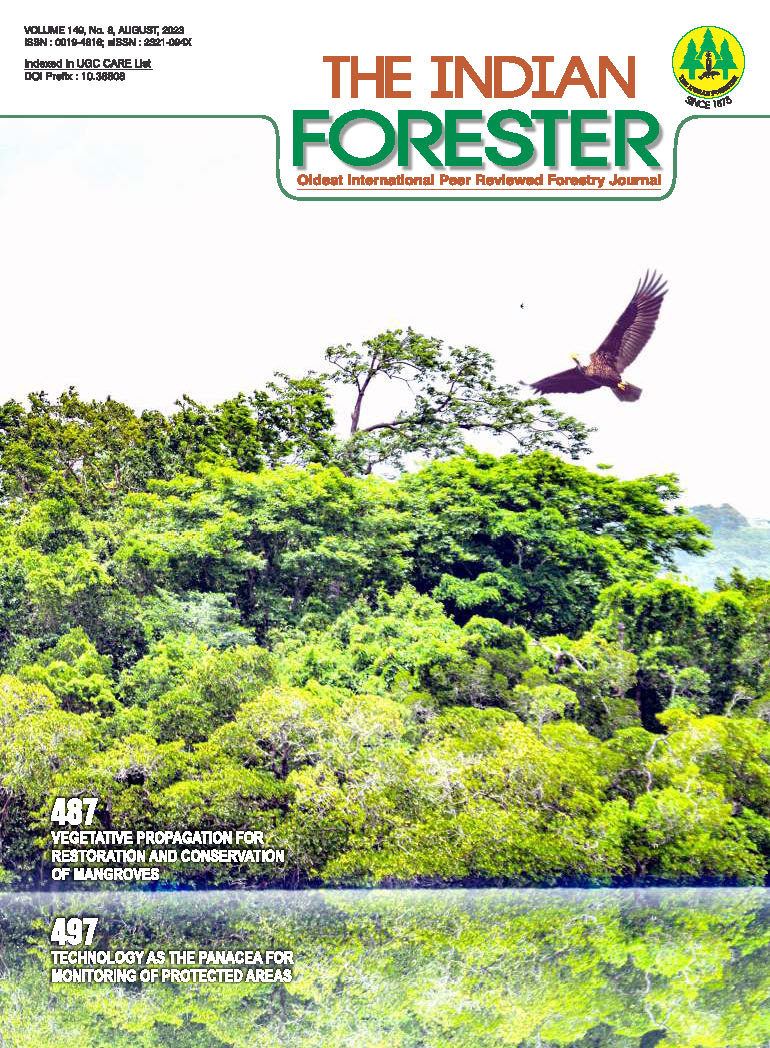Economic Feasibility of Five Year Old Melia dubia in Different Planting Densities
DOI:
https://doi.org/10.36808/if/2023/v149i8/166399Keywords:
Melia dubia, Tree Density, Economics, BCR, NPV.Abstract
This study was conducted to ascertain the economic feasibility of Melia dubia planted under different planting densities viz. (i) 2500 trees ha-1 (2x2 m), (ii) 1666 trees ha-1 (3x2 m), (iii) 1111 trees ha-1 (3x3 m) and (iv) 1250 trees ha-1 (4x2 m ), at the age of 5 years. The maximum net returns (at the age of 5 years) amounting to ₹752791 were gained from 2x2 m planting spacing with 2500 trees ha-1 . The per year net returns were in the order of 2500 trees ha-1 (2x2 m), >1666 trees ha-1 (3x2 m) >1250 trees ha-1 (4x2 m) >1111 trees ha-1 (3x3 m) with respective amounts of ₠150558>119780>99794 3x2 m>2x2 m>3x3 with respective values as 3.35>3.23>2.87>2.45. The net present value (NPV), at 5 years, was maximum (` 553278) for 2x2 m spacing followed by ₹444374, 371153 and 313230 from 3x2, 4x2 and 3x3 m spatial geometry. Although, NPV was maximum from 2x2 m planting spacing, nonetheless, internal rate of return (IRR) was highest from 4x2 m followed by 3x2, 2x2 and 3x3 m spatial geometry.References
Anon. (2019). Wood and Wood Products Update 2019, USDA, GAIN Report Number: IN9033.
Chandana P., Madhavi L.A., Khan, M.A.A. and Krishna A. (2020). Climate change smart option and doubling farmer’s income through Melia dubia-based agri-silviculture System. Current Science, 118(3): 444-448.
Chavan S.B., Keerthika A., Dhyani S.K. Handa A.K., Newaj R. and Rajarajan K. (2015). National Agroforestry Policy in India: a low hanging fruit. Current Science, 108(10): 1826-1834.
Deepika, Kumar A. and Priti S.L. (2019). Melia dubia valorization at 4, 5- and 6-year age for pulp and paper production. International Journal of Science and Research, 8 (2): 613-623.
Forest Survey of India. (2011). Forest Survey of India (Ministry of Environment Forest and Climate Change), Kaulagarh road, P.O. IPE, Dehradun 248195, Uttarakhand, India.
Forest Survey of India. (2019). Forest Survey of India (Ministry of Environment Forest and Climate Change), Kaulagarh road, Dehradun Uttarakhand, India.
IPMA. (2018). Statistical report in graphical presentation, http://ipma.co.in/statistics/ (assessed 10 August, 2018.
Jilariya D.J., Thakur N.S., Singh N. and Gunaga R.P. (2019). Economics of cultivation of Melia dubia Cav.-Aloe vera L. silvi-medicinal model. Indian Journal of Agroforestry, 21(2): 35-40.
Kulkarni H.D. (2013). Pulp and paper industry raw material scenario-ITC plantation a case study. Quarterly Journal of Indian Pulp and Paper Technical Association, 25(1): 79-89.
Kumar A., Savita., Shrivastava P., Sharma S., Dobhal S., Rana A. and Kumar R. (2017a). Development of high yielding varieties of Melia dubia Cav. (Syn. Melia composita Benth.). Indian Forester, 143(11): 1203-1206.
Kumar D., Thakur N.S. and Gunaga R.P. (2017b). Effects of leaf aqueous extract and leaf litter of Melia composita Willd. on black gram [Vigna mungo (L.) Hepper]. Allelopathy Journal, 41(1): 127-140.
Larson P.R., Kretschmann D.E., Clark A. and Isebrands J.G. (2001). Formation and Properties of Juvenile Wood in Southern Pines: A Synopsis; USDA Forest Service General Technical Report FPL-GTR 129 General Technical Report; USDA Forest Service: Madison, WI, USA, pp. 1-42.
Lodhiyal Neelu., Lodhiyal L.S. and Pangtey Y.P.S. (2002). Structure and function of shisham forests in central Himalaya, India: Dry matter dynamics. Annals of Botany, 89(1): 41-54.
Mead D.J. (2005). Opportunities for improving plantation productivity. How much? How quickly? How realistic? Biomass Bioenergy, 28: 249-266.
Mohanty S., Thakur N.S., Gunaga R.P. and Gajbhiye N. (2019). Influence of Melia dubia Cav. spatial geometries on growth, herbage yield and essential oil constituents of Cymbopogon martinii (Roxb.) Wats. Journal of Essential Oil Bearing Plants, 22(3): 630-648.
Panchal J.S., Thakur N.S., Jha S.K. and Kumar V. (2017). Productivity and carbon sequestration under prevalent agroforestry systems in Navsari district, Gujarat, India. International Journal of Current Microbiology and Applied Sciences, 6(9): 3405-3422.
Parmar A.G., Thakur N.S. and Gunaga R.P. (2019). Melia dubia Cav. leaf litter allelochemicals have ephemeral allelopathic proclivity.Agroforestry Systems, 93(4): 1347-1360.
Parthiban K.T., Chauhan S.K. and Jude S.R. (2019). Malabar Neem Melia dubia. Agrobios India, 256 p.
Prajapati D.R., Thakur N.S., Singh N., Gunaga R.P. and Patel V.R. (2020). Economic feasibility of Melia dubia-Sorgham Sudan grass based silvi-pasture systems. Indian Journal of Ecology, 47(2): 502-506.
Sinha S.K., Chaudhari P.A., Thakur N.S., Jha S.K., Patel D.P. and Dhaka R.K. (2019). Melia dubia Cav. wood properties vary with age and influence the pulp and paper quality. International Wood Products Journal, 10(4): 139-148.
Sukhadiya M.L., Thakur N.S., Gunaga R.P., Patel V.R., Bhuva D.C. and Singh S. (2019). Melia dubia Cav. drupe pulp: a new alternate livestock feed resource. Range Management Agroforestry, 40(2): 299-305.
Sukhadiya M.L., Thakur N.S., Patel V.R., Gunaga R.P., Kharadi V.B., Tyagi K.K. and Singh S. (2021). Provenance variations in proximate principles, mineral matter, total phenols and phytochemicals of Melia dubia drupes: an unexplored alternate livestock feed stock. Journal of Forestry Research, 32(1): 119-131.
Thakur N.S., Gunaga R.P., Hegde H.T., Chauhan R.S., Bhuva, D.C. and Bhusara J.B. (2021). Development of biomass and volume models of Melia dubia Cav. for early establishment. Indian Journal of Ecology, 48(3): 698-701.
Thakur N.S., Kumar D. and Gunaga R.P. (2017b). Transient allelopathic propensity of Melia composita Willd. leaf litter on chickpea (Cicer arietinum L.) Indian Journal of Ecology, 44(5): 443-450.
Thakur N.S., Kumar D. Gunaga R.P. and Singh S. (2017a). Allelopathic propensity of the aqueous leaf extract and leaf litter of Melia dubia Cav. on pulse crops. Journal of Experimental Biology and Agricultural Sciences, 5(5): 644-655.
Thakur N.S., Mohanty S., Gunaga R.P. and Gajbhiye N.A. (2020). Melia dubia Cav. spatial geometries influence the growth, yield and essential oil principles content of Cymbopogon flexuosus (Nees Ex Steud.) W. Watson. Agroforestry Systems, 94(3): 985-995.
Downloads
Downloads
Published
How to Cite
Issue
Section
License
Unless otherwise stated, copyright or similar rights in all materials presented on the site, including graphical images, are owned by Indian Forester.





